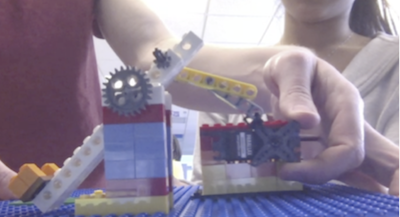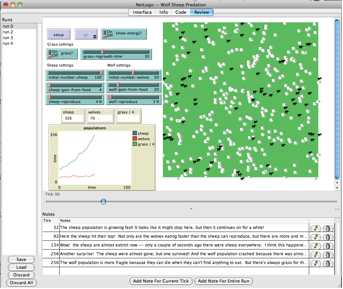Participatory Simulations

PartSims add to ABM inquiry the participation of classroom groups in collective simulations. Together, learners enact the complex phenomena they are studying through coordinated role-play, often mediated by networked computers. Students take on the goals and perspectives of specific agents (e.g., individual cars), while the classroom as a whole experiences system-level phenomena and behaviors (e.g., traffic jams) as they emerge. Thus, using PartSims, learners “dive into” phenomena and identify with particular systems elements, while at the same time, as a collective group, they experience embodying the system as a whole.
Improvments in the HubNet participatory simulation system allow teachers to easily start HubNet sessions and stundents to join the correct session regardless of possibile limitations of the school's IT infrastructure. Furthermore, in ModelSim we have innovated new forms of PartSims that include small group simulations and full class "bifocal" participatory simulations.
Improvments in the HubNet participatory simulation system allow teachers to easily start HubNet sessions and stundents to join the correct session regardless of possibile limitations of the school's IT infrastructure. Furthermore, in ModelSim we have innovated new forms of PartSims that include small group simulations and full class "bifocal" participatory simulations.
Bifocal Modeling


A considerable body of literature shows that the development of models enhances learning in STEM, but less is known about the role of physical systems in modeling. Research in this area has focused on combining “simulated labs” with physical experimentation, with little attention to computational models and physical systems connected in real time. Bifocal Modeling is an inquiry-based science learning approach in which students work with a physical experiment and a virtual model of the same phenomenon connected in real-time.
In the Particulate Nature of Matter unit, bifocal activities have become central. Early in the unit students engage in a bifocal participatory simulation to make observations about how an odor travels through a room. Later, in the "Syringineering" activity, students create physical “steam-powered” machines using a custom-made construction kit and Legos. Using the latest GoGo Boards and servo-motors, machines are driven by student-designed virtual pistons, created in an agent-based model that encoded the rules of the Kinetic Molecular Theory. This merging of the physical and virtual design processes, encourage students to see how particle motion and properties can be used to perform useful work.
In the Particulate Nature of Matter unit, bifocal activities have become central. Early in the unit students engage in a bifocal participatory simulation to make observations about how an odor travels through a room. Later, in the "Syringineering" activity, students create physical “steam-powered” machines using a custom-made construction kit and Legos. Using the latest GoGo Boards and servo-motors, machines are driven by student-designed virtual pistons, created in an agent-based model that encoded the rules of the Kinetic Molecular Theory. This merging of the physical and virtual design processes, encourage students to see how particle motion and properties can be used to perform useful work.
Emergent Systems Sandboxes

In an effort to streamline and simplify the process of building an agent-based model from scratch, we developed a class of models we call Emergent Systems Sandboxes (ESS). In an ESS model users create systems and experiments by "painting-in" objects and entities that behave according to an underlying scientific model encoded into the rules of the system. This enables classroom groups of learners to construct executable rapid prototypes of their ideas. In addition, an ESS is designed to leverage the social space of the classroom by encouraging students to publish and review executable in-process artifacts throughout the construction process.
In the Particulate Nature of Matter Unit, learners use ESS models to create various worlds in which particles move, alter the the state and locations of particles, and instrument the space with particle sensors to uncover a wide variety of experiments for describing diffusion, and by extention, the Gas Laws. Later, these ESS models are extended to allow students to automate action such as gradually changing the temperature of a segment of their model or timing the release of particles.
In the Particulate Nature of Matter Unit, learners use ESS models to create various worlds in which particles move, alter the the state and locations of particles, and instrument the space with particle sensors to uncover a wide variety of experiments for describing diffusion, and by extention, the Gas Laws. Later, these ESS models are extended to allow students to automate action such as gradually changing the temperature of a segment of their model or timing the release of particles.
Two-worlds Modeling

Seeing a need to allow users to run multiple experiments concurrently, we developed a class of models we call "two-world models." A two-world model gives students access to two adjacent worlds, each with independent parameters and outputs, but identical rules for the individuals in the world. Such models enable students to simultaneously run explorations in each world to compare a live model-run as well as its outcomes.
Two world models are used in both the Population Dynamics and Evolution units. For instance, in a Population Dynamics activity, learners investigate how temporary disturbances (e.g., a fire and disease) impact the stability and fluctuations in a population by running simultaneous explorations and comparing the plots and system dynamics in two parallel ecosystems. In the Evolution unit, learners use the Bug Hunters Camouflage model to simultaneously investigate how the adaptations emerge due to multiple factors such as the environment, predatory and mating roles, as well as mutations. In such activities, two-world models are likely to support both tinkering and more systematic investigation of each parameter.
Two world models are used in both the Population Dynamics and Evolution units. For instance, in a Population Dynamics activity, learners investigate how temporary disturbances (e.g., a fire and disease) impact the stability and fluctuations in a population by running simultaneous explorations and comparing the plots and system dynamics in two parallel ecosystems. In the Evolution unit, learners use the Bug Hunters Camouflage model to simultaneously investigate how the adaptations emerge due to multiple factors such as the environment, predatory and mating roles, as well as mutations. In such activities, two-world models are likely to support both tinkering and more systematic investigation of each parameter.
The Model Gallery

The Model Gallery allows students to present, discuss, and share both full computational artifacts as well as component features and ideas. The model gallery is composed of a shared database and a web interface. While creating or working with ModelSim models using the ABM modeling environment NetLogo, students can “post” these models to the shared database simply by pressing a button and adding a description of the artifact to be posted. In the web interface, students can then view posted artifacts made by classmates (or their own posted artifacts), leave comments for the author, and even download, run, and edit posted models.
The Model Gallery serves different functions in different units. In the Population Dynamics and Evolution units, it acts as a test bed for trying out new explorations before "going public". In others, such as in the Particulate Nature of Matter Unit, the gallery allows for the diffusion of ideas, thereby facilitating thinking and reasoning about complex scientific phenomena at the classroom scale.
The Model Gallery serves different functions in different units. In the Population Dynamics and Evolution units, it acts as a test bed for trying out new explorations before "going public". In others, such as in the Particulate Nature of Matter Unit, the gallery allows for the diffusion of ideas, thereby facilitating thinking and reasoning about complex scientific phenomena at the classroom scale.
Save/Review/Annotate/Share Model Runs

This improvement allows students to compare runs of the model they are exploring and document their observations about changes that they make between runs. This feature is designed to support individual student work, small-group work, whole-class participation using HubNet and teacher-lead whole-class activities.